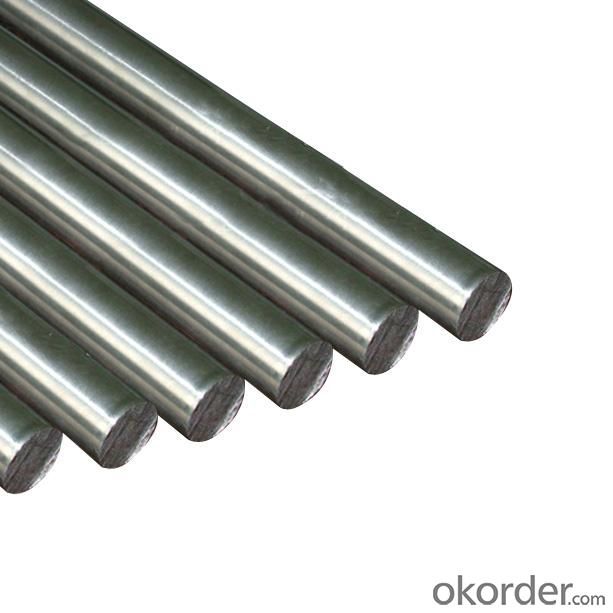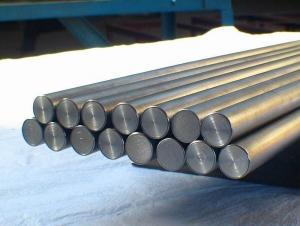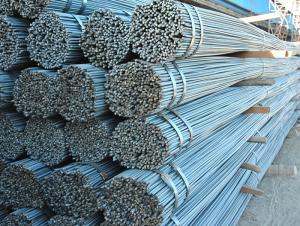Steel Round Bar 5-28mm Hot Rolled GB Q235 Q195
- Loading Port:
- China main port
- Payment Terms:
- TT OR LC
- Min Order Qty:
- 50 m.t.
- Supply Capability:
- 10000 m.t./month
OKorder Service Pledge
OKorder Financial Service
You Might Also Like
Item specifice
High Quality Round Bar 5-28mm Hot Rolled GB Q235 Q195
Product Applications:
1) Suitable for making various strong cutting tool abrasion resistance, impact resistance.
2) Used to produce all kinds of high hard and super hard saw blade, drill, tap, broach, gear hob and various kinds of milling cutter.
3) Used for advanced punching die, screw die, and the toughness and complicated shape of the punch, etc.
4) Is used for cold forging die and drawing mode, etc.
5) Recommended watchcase factory, screw factory and other cold stamping products industry use.
Product Advantages:
OKorder's High Quality Round Bar 5-28mm Hot Rolled GB Q235 Q195are durable, strong, and resist corrosion.
Main Product Features:
· Premium quality
· Prompt delivery & seaworthy packing (30 days after receiving deposit)
· Corrosion resistance
· Can be recycled and reused
· Mill test certification
· Professional Service
· Competitive pricing
Product Specifications:
1. Grade: GB, JIS, ASTM, EN
2. Grade: Q235, SS400, A36, S235JR
3. Diameter and mass: As below
Diameter | Mass | Diameter | Mass | Diameter | Mass |
(mm) | (kg/m) | (mm) | (kg/m) | (mm) | (kg/m) |
6 | 0.22 | 22 | 2.98 | 53 | 17.30 |
7 | 0.30 | 24 | 3.55 | 56 | 19.30 |
8 | 0.40 | 25 | 3.85 | 60 | 22.20 |
9 | 0.50 | 26 | 4.17 | 63 | 24.50 |
10 | 0.62 | 28 | 4.83 | 65 | 26.00 |
11 | 0.75 | 30 | 5.55 | 70 | 30.20 |
12 | 0.89 | 32 | 6.31 | 75 | 34.70 |
13 | 1.04 | 34 | 7.13 | 80 | 39.50 |
14 | 1.21 | 36 | 7.99 | 85 | 44.50 |
15 | 1.39 | 38 | 8.90 | 90 | 49.90 |
16 | 1.58 | 40 | 9.86 | 95 | 55.60 |
17 | 1.78 | 42 | 10.90 | 100 | 61.70 |
18 | 2.00 | 45 | 12.50 | 120 | 88.85 |
19 | 2.23 | 48 | 14.20 | 140 | 120.93 |
20 | 2.47 | 50 | 15.40 | 150 | 138.82 |
4. Material: Mild Steel
5. Heat treatment of high quality steel:
Fire: Isothermal annealing temperature is 800 ~ 880 °C, with 10 ~ 20 °C, the furnace cooling to about 600 °C, hardness above HB269.
Preheat temperature: 730-730 °C
Quenching temperature: 1190-1210 °C
Tempering temperature: 540-595 °C
Cold drawn, hardness 285 HBS
Cold drawn after annealing condition, hardness 277 HBS
Quenching methods: oil quenching, air cooling or salt bath quenching

- Q:Can steel round bars be used in high-temperature applications?
- High-temperature applications can indeed utilize steel round bars. Steel possesses remarkable strength and durability, enabling it to endure high temperatures without any distortion or compromise to its structural integrity. Nevertheless, the suitability of steel for high-temperature applications is contingent upon the specific type of steel and its composition. For instance, stainless steel exhibits exceptional resistance to heat and can be employed in a broad spectrum of high-temperature settings. Furthermore, certain alloy steels are purposefully crafted for use in high-temperature applications, commonly encountered in industries like aerospace or petrochemicals. It is crucial to consult experts and carefully consider the specific requirements of the application in order to select the most appropriate steel round bars for high-temperature conditions.
- Q:What is the maximum elongation of steel round bars?
- The maximum elongation of steel round bars depends on various factors such as the type of steel, its composition, and the manufacturing process. However, in general, steel round bars can have elongation values ranging from 10% to 30% before they reach their maximum limit and start to deform permanently.
- Q:What are the different types of steel round bar machining processes?
- There are several different types of steel round bar machining processes, each with its own unique characteristics and applications. Some of the most common types include: 1. Turning: This process involves rotating the steel round bar against a cutting tool, which removes material to create the desired shape. Turning is often used to create cylindrical shapes or to remove excess material from the surface. 2. Drilling: Drilling is a machining process that involves creating holes in the steel round bar using a rotating cutting tool. This process is commonly used to create holes for bolts or other fasteners. 3. Milling: Milling is a versatile machining process that involves removing material from the surface of the steel round bar using a rotating cutting tool. This process can be used to create complex shapes, slots, or grooves. 4. Grinding: Grinding is a machining process that uses an abrasive wheel to remove material from the surface of the steel round bar. This process is often used to achieve a smooth finish or to remove any imperfections on the surface. 5. Boring: Boring is a process that involves enlarging an existing hole in the steel round bar using a cutting tool. This process is commonly used to create larger diameter holes or to achieve greater precision. 6. Knurling: Knurling is a machining process that involves creating a pattern of ridges or grooves on the surface of the steel round bar. This process is often used to improve grip or to create a decorative effect. 7. Thread cutting: Thread cutting is a process that involves creating external or internal threads on the surface of the steel round bar. This process is commonly used to create threaded holes or to create threaded fasteners. These are just a few examples of the different types of steel round bar machining processes. Each process has its own advantages and limitations, and the choice of which process to use will depend on the specific requirements of the application.
- Q:Are steel round bars available in metric sizes?
- Yes, steel round bars are available in metric sizes.
- Q:How are steel round bars used in the construction of railways?
- Steel round bars are commonly used in the construction of railways as they provide strength, durability, and stability to the railway tracks. These bars are typically laid horizontally and are used to support the rails, ensuring that they remain in place and can withstand heavy loads and constant train traffic. The round shape of the bars allows for uniform distribution of weight and reduces the risk of structural failure. Additionally, steel round bars are often used to reinforce the concrete foundations and structures associated with railway construction, further enhancing the overall stability and longevity of the railway system.
- Q:What are the factors to consider when selecting a steel round bar?
- There are several factors to take into account when choosing a steel round bar. Firstly, it is crucial to evaluate the grade of steel. Each grade has different properties and strengths, so it is important to consider the specific application and requirements. For instance, if high corrosion resistance is needed, stainless steel grades such as 304 or 316 may be appropriate, while carbon steel grades like A36 or 1018 may be more suitable for structural purposes. Secondly, the dimensions and size of the round bar should be considered. This includes the diameter, length, and tolerance requirements. The size should be chosen based on the specific application, load-bearing capacity, and available installation space. Thirdly, the condition and surface finish of the round bar should be assessed. This includes factors like surface roughness, straightness, and any surface defects. The surface finish should be selected based on the desired aesthetics, functional requirements, and manufacturing process. Another important aspect is the availability and cost of the steel round bar. It is crucial to consider the availability of the desired grade and size from suppliers, as well as the associated cost. Comparing prices from different suppliers is advisable to ensure the best value for money. Furthermore, it is necessary to evaluate the required mechanical properties of the steel round bar. This includes factors like tensile strength, yield strength, hardness, and ductility. The mechanical properties should align with the intended application and load-bearing requirements. Lastly, any additional requirements or certifications should be considered. This could include compliance with specific industry standards (e.g., ASTM, ISO), certifications (e.g., RoHS, REACH), or specific testing requirements (e.g., ultrasonic testing, impact testing). In conclusion, selecting a steel round bar involves considering the grade, dimensions, surface finish, availability, cost, mechanical properties, and any additional requirements. Taking these factors into account will ensure that the chosen steel round bar is suitable for the intended application and meets all necessary specifications.
- Q:What is the standard length of a steel round bar?
- The standard length of a steel round bar varies depending on the manufacturer and the specific application. However, common standard lengths range from 6 to 12 feet (1.8 to 3.6 meters).
- Q:Are steel round bars suitable for use in the oil and gas industry?
- Yes, steel round bars are suitable for use in the oil and gas industry. Steel round bars are known for their strength, durability, and high resistance to corrosion, which makes them well-suited for the challenging and harsh environments encountered in the oil and gas industry. These bars are commonly used in various applications such as drilling tools, valves, pipelines, and offshore structures. The oil and gas industry involves operations in offshore rigs, refining facilities, and pipelines that are exposed to extreme temperatures, pressures, and corrosive substances. Steel round bars are capable of withstanding these conditions and maintaining their structural integrity, making them a reliable choice for critical components. Another advantage of steel round bars is their versatility. They can be easily machined, welded, and fabricated into different shapes and sizes, allowing for customization to meet specific project requirements. This flexibility is crucial in the oil and gas industry, which often demands unique and complex equipment. Furthermore, steel round bars offer excellent mechanical properties, including high tensile strength and impact resistance, which are essential for withstanding heavy loads and dynamic forces associated with oil and gas operations. Their ability to handle these loads ensures the safety and reliability of equipment and structures in the industry. In addition to their mechanical properties, steel round bars have a high resistance to corrosion, which is critical in the oil and gas industry due to the presence of corrosive substances such as hydrogen sulfide and saltwater. Corrosion resistance ensures the longevity and reliability of equipment, reducing maintenance costs and downtime. Overall, steel round bars are a suitable choice for use in the oil and gas industry due to their strength, durability, corrosion resistance, and versatility. These properties make them ideal for various applications, ensuring the safe and efficient operation of equipment and structures in this demanding industry.
- Q:What are the different grades of tool steel round bars?
- Various grades of tool steel round bars are offered, each possessing unique properties and characteristics tailored to specific applications. Examples of these grades include: 1. W1: With its relatively low carbon content, W1 is a water-hardening tool steel renowned for its exceptional toughness and good wear resistance. It finds common usage in cutting tools and woodworking tools. 2. O1: O1 tool steel round bars are oil-hardening tool steel boasting high carbon content. They exhibit excellent wear resistance, high toughness, and exceptional dimensional stability. O1 tool steel is frequently employed for punches, dies, and cutting tools. 3. A2: A2 tool steel round bars are air-hardening tool steel with moderate carbon and chromium content. They offer good wear resistance, superior toughness, and high dimensional stability. A2 tool steel is a popular choice for blanking and forming dies, as well as shear blades. 4. D2: D2 tool steel round bars are characterized by their high carbon and chromium content, providing outstanding wear resistance and good toughness. They exhibit remarkable resistance to abrasive wear and are commonly utilized in the production of cutting tools, punches, and forming dies. 5. M2: High-speed M2 tool steel round bars are enriched with a notable amount of tungsten, molybdenum, and vanadium. They deliver exceptional wear resistance, high red hardness, and good toughness. M2 tool steel is typically employed for high-speed cutting tools, drill bits, and machining tools. 6. S7: S7 tool steel round bars are air-hardening shock-resistant tool steel. They possess high impact toughness, good wear resistance, and excellent heat resistance. S7 tool steel is frequently applied in applications necessitating high shock resistance, such as chisels and hammers. These are merely a few instances of the diverse grades of tool steel round bars available in the market. The choice of grade hinges on factors such as the specific application, desired hardness, wear resistance, toughness, and heat resistance required. It is crucial to seek guidance from a knowledgeable supplier or metallurgist to ascertain the most appropriate grade for a given application.
- Q:How do you calculate the weight of a steel round bar based on its length and diameter?
- To calculate the weight of a steel round bar, you can use the formula: weight = (pi * diameter^2 * length) / 4.
1. Manufacturer Overview |
|
|---|---|
| Location | |
| Year Established | |
| Annual Output Value | |
| Main Markets | |
| Company Certifications | |
2. Manufacturer Certificates |
|
|---|---|
| a) Certification Name | |
| Range | |
| Reference | |
| Validity Period | |
3. Manufacturer Capability |
|
|---|---|
| a)Trade Capacity | |
| Nearest Port | |
| Export Percentage | |
| No.of Employees in Trade Department | |
| Language Spoken: | |
| b)Factory Information | |
| Factory Size: | |
| No. of Production Lines | |
| Contract Manufacturing | |
| Product Price Range | |
Send your message to us
Steel Round Bar 5-28mm Hot Rolled GB Q235 Q195
- Loading Port:
- China main port
- Payment Terms:
- TT OR LC
- Min Order Qty:
- 50 m.t.
- Supply Capability:
- 10000 m.t./month
OKorder Service Pledge
OKorder Financial Service
Similar products
New products
Hot products
Related keywords






























